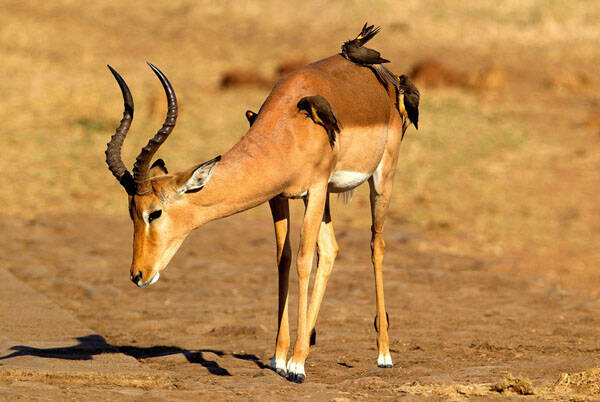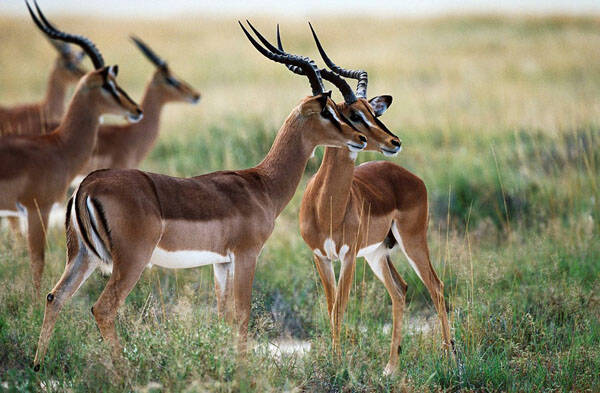Aepyceros melampus
IUCN
LCBasic Information
Scientific classification
- name:Aepyceros melampus
- Scientific Name:Aepyceros melampus,Impala,Common Impala
- Outline:Ungulata
- Family:Artiodactyla Bovidae Hippodrome
Vital signs
- length:About 130 cm
- Weight:40-60kg
- lifetime:6-12years
Feature
Characterized by its long horns and extremely fast running speed, it is also called the flying antelope.
Distribution and Habitat
Origin: Angola, Botswana, Kenya, Malawi, Mozambique, Namibia, Rwanda, South Africa, Swaziland, United Republic of Tanzania, Uganda, Zambia and Zimbabwe.
Extinct in: Burundi. Introduced: Gabon.
The impala lives in the forests and grasslands of southern and central Africa, at the junction of forests and grasslands. Because the forests can hide themselves, if they are discovered, they will run to the grasslands.
Appearance
The antelope is a kind of antelope. It is a small to medium-sized bovine animal. It is not significantly different from other antelopes and is characterized by its long horns. In addition, it runs very fast, so it is also called the flying antelope.
It weighs about 40-60 kg and is about 75-100 cm tall at the shoulder. It is sexually dimorphic, and females have no horns. Males have horns, which are very long, harp-shaped or S-shaped, bending backwards and then upwards, and can reach 0.5-0.8 meters; the ridges on these horns form a ridge, which is thin and the tips of the two horns are far apart.
Both males and females have the same color, with golden, red, reddish brown or reddish brown fur on the back and dull on the sides of the abdomen. The abdomen, chin, lips, bottom of the ears, eye stripes and tail are white. There is a vertical black stripe on the forehead, both legs, earlobes and tail. These black stripes may help to recognize and distinguish between individuals. There is
Details
Impala (scientific name: Aepyceros melampus) is also known as Impala and Common Impala in foreign languages. There are 6 subspecies.

Impalas live on grasslands and thick bushes. They do not migrate and like to live in groups, usually between 15 and 60. The size of the herd forms a certain social structure according to the season. The average size of the female herd is between 15 and 100 individuals within a family range of 80-180 hectares. In the rainy season, the territory is heavily defended, but in the dry season there is no family or even clan territory, and there is a lot of overlap. There are subtle differences in behavior between southern and eastern antelopes. Southern antelopes are more likely to mix areas in the dry season, while eastern antelopes only cross-use water and food in the same area in the dry season.
The antelopes are agile and run fast, with a maximum speed of 95 kilometers per hour, and often move in large groups near water. They are famous for their elegant posture and excellent jumping ability. When frightened, they can jump 3 meters high and 9 meters away. They are herbivorous animals, and their food is mainly leaves, bark or plant roots.

Male antelopes can mate at the age of one and a half, but they have to wait until they are three years old and successfully defeat their opponents to become the leader of the group before they are eligible to mate with the female antelopes in the group. During the breeding season, male antelopes will use a variety of methods to defend their territory (encircling the females in the territory). Tail up, forehead up, forehead bumping, upright, fighting, roaring.
The antelope breeds once a year. The breeding season is from March to May, and only one baby is born. The gestation period is 194-200 days. The lactation period is 4-7 months, with an average of 4.5 months. Most of them are single births. When the birth is approaching, the female antelope will leave the group to give birth alone. The baby antelope will be hidden in a hidden place within one or two days after birth. The wonder of nature is that almost all baby antelopes are born within a few days. This "sea of antelopes tactics" can prevent all the baby antelopes from being eaten.
In Africa, the number of antelopes is more than 2 million. The species has a wide distribution range and is not close to the vulnerable and endangered critical value standard for species survival (distribution area or fluctuation range less than 20,000 square kilometers, habitat quality, population size, and fragmented distribution area). The population trend is stable, so it is evaluated as a species without survival crisis.
Listed in the 2013 Red List of Threatened Species of the World Conservation Union (IUCN) ver 3.1 - Low Concern (LC).
Protect wild animals and eliminate game.
Maintaining ecological balance is everyone's responsibility!








